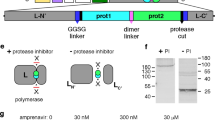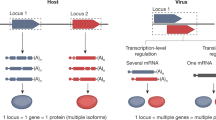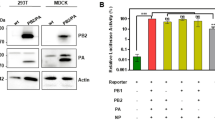Abstract
The high error rates of viral RNA-dependent RNA polymerases create heterogeneous viral populations whose disparate RNA genomes affect each other's survival. We systematically screened the poliovirus genome and identified four sets of dominant mutations. Mutated alleles in capsid- and polymerase-coding regions resulted in dominant negative phenotypes, probably due to the proteins' oligomeric properties. We also identified dominant mutations in an RNA element required for priming RNA synthesis (CRE) and in the protein primer (VPg), suggesting that nonproductive priming intermediates are inhibitory. Mutations that inhibit the activity of viral proteinase 2A were dominant, arguing that inhibition of its known intramolecular activity creates a toxic product. Viral products that, when defective, dominantly interfere with growth of nondefective viruses will probably be excellent drug targets because drug-sensitive viruses should be dominant over drug-resistant variants. Accordingly, a virus sensitive to anticapsid compound WIN51711 dominantly inhibited the intracellular growth of a drug-resistant virus. Therefore, dominant inhibitor screening should validate or predict targets for antiviral therapy with reduced risk for drug resistance.
This is a preview of subscription content, access via your institution
Access options
Subscribe to this journal
Receive 12 print issues and online access
$209.00 per year
only $17.42 per issue
Buy this article
- Purchase on Springer Link
- Instant access to full article PDF
Prices may be subject to local taxes which are calculated during checkout







Similar content being viewed by others
Accession codes
References
Domingo, E. & Holland, J.J. RNA virus mutations and fitness for survival. Annu. Rev. Microbiol. 51, 151–178 (1997).
Ledinko, N. & Hirst, G.K. Mixed infection of HeLa cells with polioviruses types 1 and 2. Virology 14, 207–219 (1961).
Holland, J.J. & Cords, C.E. Maturation of poliovirus RNA with capsid protein coded by heterologous enteroviruses. Proc. Natl. Acad. Sci. USA 51, 1082–1085 (1964).
Ikegami, N., Eggers, H.J. & Tamm, I. Rescue of drug-requiring and drug-inhibited enteroviruses. Proc. Natl. Acad. Sci. USA 52, 1419–1426 (1964).
Holland, J.J. et al. Virus mutation frequencies can be greatly underestimated by monoclonal antibody neutralization of virions. J. Virol. 63, 5030–5036 (1989).
Paul, A.V. Possible unifying mechanism of picornavirus genome replication. in Molecular Biology of Picornaviruses (eds. B.L. Semler & E. Wimmer) 227–246 (ASM Press, Washington, D.C., 2002).
Kaplan, G. & Racaniello, V.R. Construction and characterization of poliovirus subgenomic replicons. J. Virol. 62, 1687–1696 (1988).
Novak, J.E. & Kirkegaard, K. Coupling between genome translation and replication in an RNA virus. Genes Dev. 8, 1726–1737 (1994).
Lyle, J.M., Bullitt, E., Bienz, K. & Kirkegaard, K. Visualization and functional analysis of RNA-dependent RNA polymerase lattices. Science 296, 2218–2222 (2002).
Thompson, A.A. & Peersen, O.B. Structural basis for proteolysis-dependent activation of the poliovirus RNA-dependent RNA polymerase. EMBO J. 23, 3462–3471 (2004).
Paul, A.V., Rieder, E., Kim, D.W., van Boom, J.H. & Wimmer, E. Identification of an RNA hairpin in poliovirus RNA that serves as the primary template in the in vitro uridylylation of VPg. J. Virol. 74, 10359–10370 (2000).
Herskowitz, I. Functional inactivation of genes by dominant negative mutations. Nature 329, 219–222 (1987).
Yin, J., Paul, A.V., Wimmer, E. & Rieder, E. Functional dissection of a poliovirus cis-acting replication element [PV-cre(2C)]: analysis of single- and dual-cre viral genomes and proteins that bind specifically to PV-cre RNA. J. Virol. 77, 5152–5166 (2003).
Murray, K.E. & Barton, D.J. Poliovirus CRE-dependent VPg uridylylation is required for positive-strand RNA synthesis but not for negative-strand RNA synthesis. J. Virol. 77, 4739–4750 (2003).
Andino, R., Rieckhof, G.E., Achacoso, P.L. & Baltimore, D. Poliovirus RNA synthesis utilizes an RNP complex formed around the 5′-end of viral RNA. EMBO J. 12, 3587–3598 (1993).
Hambidge, S.J. & Sarnow, P. Translational enhancement of the poliovirus 5′ noncoding region mediated by virus-encoded polypeptide 2A. Proc. Natl. Acad. Sci. USA 89, 10272–10276 (1992).
Macadam, A.J. et al. 1994. Role for poliovirus protease 2A in cap independent translation. EMBO J. 13, 924–927 (1994).
Toyoda, H. et al. A second virus-encoded proteinase involved in proteolytic processing of poliovirus polyprotein. Cell 45, 761–770 (1986).
Hellen, C.U., Lee, C.K. & Wimmer, E. Determinants of substrate recognition by poliovirus 2A proteinase. J. Virol. 66, 3330–3338 (1992).
Lyons, T., Murray, K.E., Roberts, A.W. & Barton, D.J. Poliovirus 5′-terminal cloverleaf RNA is required in cis for VPg uridylylation and the initiation of negative-strand RNA synthesis. J. Virol. 75, 10696–10708 (2001).
Agut, H. et al. A point mutation in the poliovirus polymerase gene determines a complementable temperature-sensitive defect of RNA replication. Virology 168, 302–311 (1989).
Charini, W.A., Burns, C.C., Ehrenfeld, E. & Semler, B.L. trans rescue of a mutant poliovirus RNA polymerase function. J. Virol. 65, 2655–2665 (1991).
Johnson, K.L. & Sarnow, P. Three poliovirus 2B mutants exhibit noncomplementable defects in viral RNA amplification and display dosage-dependent dominance over wild-type poliovirus. J. Virol. 65, 4341–4349 (1991).
Compton, S.R., Nelsen, B. & Kirkegaard, K. Temperature-sensitive poliovirus mutant fails to cleave VP0 and accumulates provirions. J. Virol. 64, 4067–4075 (1990).
Hope, D.A., Diamond, S.E. & Kirkegaard, K. Genetic dissection of interaction between poliovirus 3D polymerase and viral protein 3AB. J. Virol. 71, 9490–9498 (1997).
Fox, M.P., Otto, M.J. & McKinlay, M.A. Prevention of rhinovirus and poliovirus uncoating by WIN 51711, a new antiviral drug. Antimicrob. Agents Chemother. 30, 110–116 (1986).
Chapman, M.S., Minor, I., Rossmann, M.G., Diana, G.D. & Andries, K. Human rhinovirus 14 complexed with antiviral compound R 61837. J. Mol. Biol. 217, 455–463 (1991).
Mosser, A.G., Sgro, J.Y. & Rueckert, R.R. Distribution of drug resistance mutations in type 3 poliovirus identifies three regions involved in uncoating functions. J. Virol. 68, 8193–8201 (1994).
Pevear, D.C., Tull, T.M., Seipel, M.E. & Groarke, J.M. Activity of pleconaril against enteroviruses. Antimicrob. Agents Chemother. 43, 2109–2115 (1999).
Jubelt, B., Wilson, A.K., Ropka, S.L., Guidinger, P.L. & McKinlay, M.A. Clearance of a persistent human enterovirus infection of the mouse central nervous system by the antiviral agent disoxaril. J. Infect. Dis. 159, 866–871 (1989).
Groarke, J.M. & Pevear, D.C. Attenuated virulence of pleconaril-resistant coxsackievirus B3 variants. J. Infect. Dis. 179, 1538–1541 (1999).
Preugschat, F., Yao, C.-W. & Strauss, J.H. In vitro processing of Dengue virus type 2 nonstructural proteins NS2A, NS2B, and NS3. J. Virol. 64, 4364–4374 (1990).
Rost, B. & Sander, C. Conservation and prediction of solvent accessibility in protein families. Proteins 20, 216–226 (1994).
Ho, S.N., Hunt, H.D., Horton, R.M., Pullen, J.K. & Pease, L.R. Site-directed mutagenesis by overlap extension using the polymerase chain reaction. Gene 77, 51–59 (1989).
Kirkegaard, K. Mutations in VP1 of poliovirus specifically affect both encapsidation and release of viral RNA. J. Virol. 64, 195–206 (1990).
Barton, D.J., O'Donnell, B.J. & Flanegan, J.B. 5′ cloverleaf in poliovirus RNA is a cis-acting replication element required for negative-strand synthesis. EMBO J. 20, 1439–1448 (2001).
Jarvis, T.C. & Kirkegaard, K. Poliovirus RNA recombination: mechanistic studies in the absence of selection. EMBO J. 11, 3135–3145 (1992).
Ansardi, D.C. & Morrow, C.D. Amino acid substitutions in the poliovirus maturation cleavage site affect assembly and result in accumulation of provirions. J. Virol. 69, 1540–1547 (1995).
Reynolds, C., Page, G., Zhou, H. & Chow, M. Identification of residues in VP2 that contribute to poliovirus neutralization antigenic site 3B. Virology 184, 391–396 (1991).
Yu, S.F. & Lloyd, R.E. Identification of essential amino acid residues in the functional activity of poliovirus 2A proteinase. Virology 182, 615–625 (1991).
Rothberg, P.G., Harris, T.J., Nomoto, A. & Wimmer, E. O4-(5′-uridylyl)tyrosine is the bond between the genome-linked protein and the RNA of poliovirus. Proc. Natl. Acad. Sci. USA 75, 4868–4872 (1978).
Ambros, V. & Baltimore, D. Protein is linked to the 5′ end of poliovirus RNA by a phosphodiester linkage to tyrosine. J. Biol. Chem. 253, 5263–5266 (1978).
Hammerle, T., Hellen, C.U. & Wimmer, E. Site-directed mutagenesis of the putative catalytic triad of poliovirus 3C proteinase. J. Biol. Chem. 266, 5412–5416 (1991).
Hobson, S.D. et al. Oligomeric structures of poliovirus polymerase are important for function. EMBO J. 20, 1153–1163 (2001).
Hansen, J.L., Long, A.M. & Schultz, S.C. Structure of the RNA-dependent RNA polymerase of poliovirus. Structure 5, 1109–1122 (1997).
Burns, C.C., Lawson, M.A., Semler, B.L. & Ehrenfeld, E. Effects of mutations in poliovirus 3Dpol on RNA polymerase activity and on polyprotein cleavage. J. Virol. 63, 4866–4874 (1989).
Goodfellow, I. et al. Identification of a cis-acting replication element within the poliovirus coding region. J. Virol. 74, 4590–4600 (2000).
Petersen, J.F. et al. The structure of the 2A proteinase from a common cold virus: a proteinase responsible for the shut-off of host-cell protein synthesis. EMBO J. 18, 5463–5475 (1999).
Acknowledgements
We thank S. Dutcher, P. Sarnow and J. Theriot for reading the manuscript; P. Harbury for editing; J.M. Lyle for experimental insights; and A. Mosser and A. Macadam for advice and reagents. This work was supported by the US National Institutes of Health (National Research Service Award to S.C.), the Hutchison Program in Translational Medicine and the Ellison Medical Foundation.
Author information
Authors and Affiliations
Corresponding author
Ethics declarations
Competing interests
The authors declare no competing financial interests.
Supplementary information
Supplementary Table 1
Phenotypes of temperature-sensitive polioviruses generated by hydrophobic mutations. (PDF 2509 kb)
Supplementary Table 2
Dominant inhibitor screen results of mutant 2B, 2C, 3A, and 3C alleles. (PDF 4946 kb)
Supplementary Table 3
Summary of dominant negative alleles of poliovirus. (PDF 386 kb)
Rights and permissions
About this article
Cite this article
Crowder, S., Kirkegaard, K. Trans-dominant inhibition of RNA viral replication can slow growth of drug-resistant viruses. Nat Genet 37, 701–709 (2005). https://doi.org/10.1038/ng1583
Received:
Accepted:
Published:
Issue Date:
DOI: https://doi.org/10.1038/ng1583
This article is cited by
-
Quasispecies and virus
European Biophysics Journal (2018)
-
Attenuation of RNA viruses by redirecting their evolution in sequence space
Nature Microbiology (2017)
-
The role of mutational robustness in RNA virus evolution
Nature Reviews Microbiology (2013)
-
Combating natural selection with 'antiviral Judo'
Nature Methods (2005)



